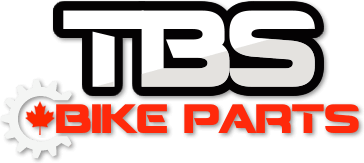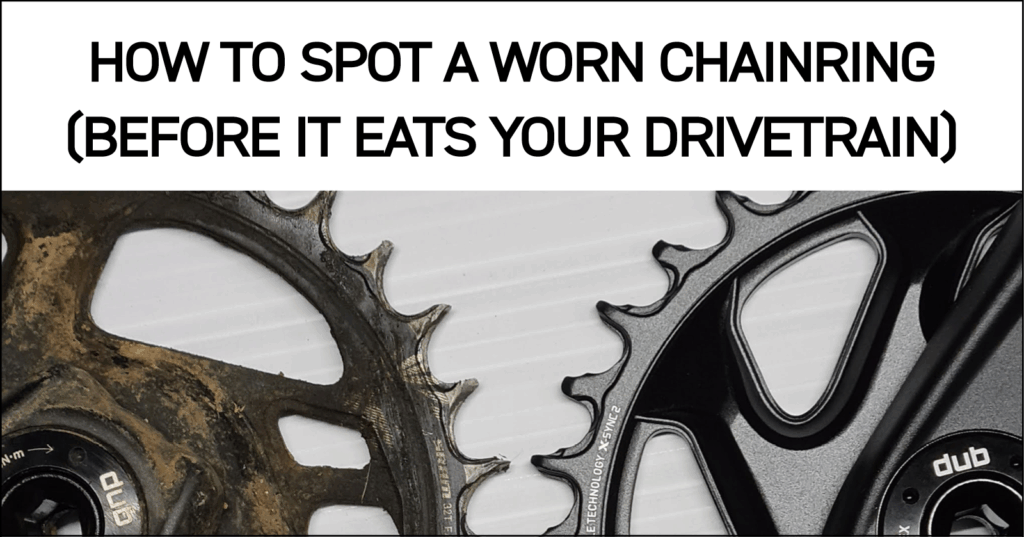Your chainring might look like it’s still good to go, but if it’s worn, it can quietly trash your chain and cassette. Catching it early saves you money and keeps your drivetrain running smooth. Here’s how to know when it’s time to swap it out.
1. Look at the Teeth Shape
Fresh chainring teeth are symmetrical and slightly squared off. Worn teeth start to look:
-
Shark-finned – pointy and ramped forward like a shark’s tooth.
-
Hooked – one side of the tooth is taller or sharper than the other.
-
Thinned out – they look like they’ve been filed down compared to new ones.
If your teeth look more like blades than blocks, it’s a sign your chainring is on its last laps.
2. Chain Slipping or Skipping
If your chain is skipping under load, especially when climbing or sprinting, it’s not always your derailleur’s fault. Worn chainring teeth can’t hold the chain properly, which causes it to ride up and slip. If you’ve already replaced your chain and cassette, but skipping continues, the ring is usually the culprit.
3. Noise You Can’t Tune Out
Creaks, grinding, or chain chatter that won’t go away after cleaning and lubing often point to uneven tooth wear. A chainring that’s no longer meshing smoothly will cause extra drivetrain noise.
4. Uneven Wear on the Teeth
Flip your bike upside down and spin the cranks slowly. If you see:
-
Some teeth looking way shorter than others.
-
“Polished” sections where the anodizing is worn off unevenly.
-
Teeth with burrs or sharp edges.
That’s wear creeping in—and it won’t get better with time.
5. The Chain Stretch Test
If you’ve been running a stretched chain for too long, chances are your chainring is already damaged. A chain checker tool will tell you when a chain is past spec. If you’ve blown past the 0.75–1.0% wear marks, your ring (and cassette) have been grinding along with it.
Why Replacing Matters
Running a worn chainring does two things:
-
Chews through chains and cassettes way faster than normal.
-
Kills shifting performance—no one wants ghost shifts in the middle of a climb.
A new chainring costs way less than a new drivetrain. Swapping it before it’s completely shot will save you big in the long run.
Pro Tip
If you’re unsure, grab a photo of your chainring and compare it to a brand-new one online (or at your local shop). The difference in tooth shape is usually obvious once you see them side by side.
Final Thoughts
Your chainring won’t last forever, but catching wear early is the difference between a simple part swap and a full drivetrain replacement. If you spot shark-finned teeth, feel your chain slipping, or hear noise you can’t tune out, don’t ignore it—your drivetrain’s already telling you something’s wrong. Replacing a worn ring is cheaper, faster, and way less frustrating than waiting until it eats through your chain and cassette. Stay ahead of the wear, and your bike will thank you every ride.
Remember that we offer free shipping on all orders over $149CAD. Orders are all processed and shipped within 24 business hours as well. Looking for mountain bike parts? We stock hundreds of parts from multiple brands and you can shop our entire selection here.
Spend less and ride the best with TBS Bike Parts.
Related Articles
WHEN TO REPLACE MTB PARTS: A GUIDE TO COMPONENT LIFESPAN
BREAKDOWN OF SHIMANO LINKGLIDE 11-SPEED DRIVETRAIN
AFTERMARKET MTB COMPONENTS: WHY IT PAYS TO UPGRADE
HOW LIGHTWEIGHT MTB COMPONENTS CAN IMPROVE YOUR RIDE
15 MOUNTAIN BIKE ACCESSORIES YOU DIDN’T KNOW YOU NEEDED


